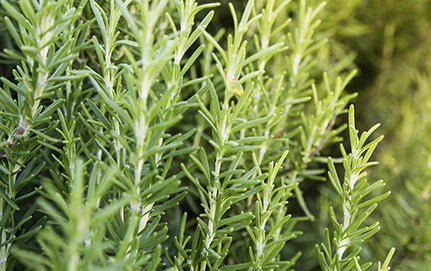Soothing and invigorating when used as an essential oil.
Plant name (Latin): Rosmarinus officinalis
Plant family: Lamiaceae (mint family)
Native region: Warm, dry and sunny regions of the Mediterranean
Growing habit: Woody perennial with short, needle-like leaves and small blooms
Parts used: Flowers, stalks and leaves
Essential oil extraction method: Steam distillation
About Rosemary Oil
Rosemary has been used for thousands of years in cooking, aromatherapy, plant medicine, and as a symbol of love and remembrance. Rosemary has a herbal, pine-like scent that is sometimes referred to as ‘balsamic’. Rosemary essential oil is often included in blends for its ability to invigorate the mind and senses.

Why Use Rosemary Oil
Stimulating and warming, this herbal essential oil helps release stressful feelings and soothes the skin while keeping your mind sharp and your senses invigorated.
How the Rosemary Plant Grows
Rosemary is a woody perennial (lives for several years), with fragrant, evergreen leaves that look similar to pine tree needles, and very small, white, pink or purple blooms. In temperate regions, rosemary will produce flowers in spring and summer, but can bloom year-round in warmer places. Rosemary plants can be trailing or upright, with upright varieties growing up to 1.5 metres (5 feet) or more. In warm climates, you can see rosemary grow into large bushes that are often pruned into a topiary.
Rosemary is native to the Mediterranean region, and thrives in warmer, dryer, sunny regions. If you live in a very cold area, a rosemary plant can survive in containers brought indoors over winter. Technically, it prefers USDA hardiness zone 7 and up but will grow in zone 6. This easy-to-grow plant is tolerant of drought, but does not like being waterlogged.
Rosemary essential oil is steam-distilled from the flowering tops, stalks and leaves of the rosemary plant. Rosemary essential oil is extracted from the same plant used as an herb in cooking.
Rosemary Oil in Ayurveda
Rosemary essential oil is believed to have a drying and healing type of energy. Rosemary essential oil is used to reduce excess vata and kapha, and is thought to increase pitta. In Ayurvedic treatments, rosemary essential oil is used as a tonic for the hair and skin, and to help with negative moods and tiredness.
The Symbolism of the Rosemary Plant
Rosemary is associated with the astrological sign Leo, the element of fire, the Sun, and is thought to be male in nature. The name rosemary comes from Latin for "dew" (ros) and "sea" (marinus), or "dew of the sea", although an alternative myth suggests that the fragrant plant became known as “Rose of Mary” after the Virgin Mary spread her blue cloak over a white-blossomed rosemary bush when she was resting, and the flowers turned blue.
Rosemary has been used in ceremonies and spiritual rituals for thousands of years. The ancient Greeks believed that rosemary was a gift from Aphrodite, goddess of love, and therefore rosemary frequently appeared at weddings. Rosemary continued to be used in European wedding ceremonies as a symbol of love and remembrance through the Middle Ages. In the Shakespearean play, Hamlet, Ophelia hands rosemary to Hamlet and says, “There's rosemary, that’s for remembrance.” Rosemary was also used at funerals, as a pledge never to forget.
On ANZAC Day, the Australian and New Zealand day of commemoration of World War I, rosemary is worn to remember ANZAC sacrifices in war. Rosemary grows on the Galipoli peninsula in Turkey, where ANZAC soldiers landed on April 25, 1915.
If you are a fan of folk music, you’ll probably remember the chorus to Scarborough Fair, an old English folk song popularized by Simon and Garfunkel in the 1960s: “Parsley, sage, rosemary and thyme; she once was a true love of mine.”
The History of Rosemary

Rosemary was extremely popular in Europe through medieval times and into the Renaissance. Rosemary was thought to have the power to prevent negativity from entering a house, and people would tuck rosemary under their pillows to ward off bad dreams and evil spirits.
In the 13th century, Queen Elizabeth of Hungary suffered from gout and rheumatism. She used rosemary water to treat this condition, and claimed that rosemary helped her regain her beauty and strength – so much so that at 72 years old, the monarch received a marriage proposal from the 26-year-old King of Poland.
The Science of Rosemary Oil
In the 14th century, Hungary Water, Europe’s first alcohol-based perfume, was scented with rosemary essential oil. In the 15th and 16th century, rosemary became well-known in English herbalism for its medicinal and beautifying properties. Blanckes' Herbal, published in England around 1525, suggests that washing with rosemary essential oils would give you “a fayre face”. Blanckes also suggests that smelling rosemary “shall preserve thy youthe,” and recommends rosemary tea “for much worth against all evils of the body.”
English writer Gervase Markham offered similar advice in 1615, in his work “English Housewife”. He said, “rosemary water (the face washed therein both morning and night) causeth a fair and clear countenance.” Furthermore; “when one maketh a bath of this decoction, it is called the bath of life, the same drunk comforteth the heart, the brain, and the whole body, and cleanseth away the spots of the face; it maketh a man look young . . .”
Rosemary was the favorite perfume of Napoleon of France. Josephine, his great love, is said to have demanded that he bathe in rosemary water before joining her in bed. Napoleon’s royal perfumer recorded that he used 162 bottles of rosemary water in the first three months of 1806.
